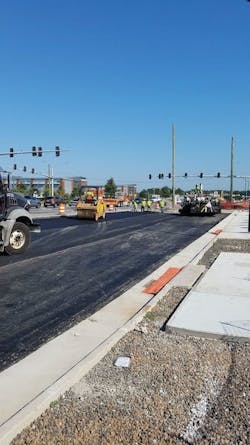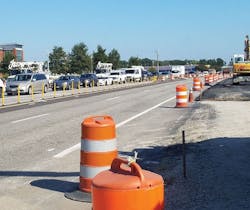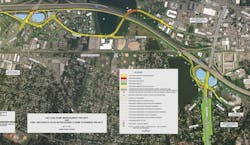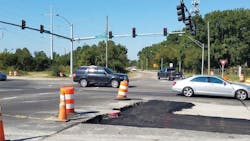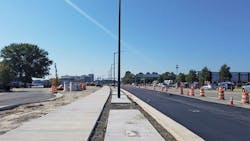How extensive preparation and planning is helping minimize reconstruction disruption on a busy Virginia route
In 1706, a woman thought to be a witch was “ducked” into the Lynnhaven River in what is now Virginia Beach. Local authorities tried her by tying her thumbs to her big toes and dropping her into the water: If she sank, she would be deemed innocent; if she floated, she was guilty.
Grace Sherwood managed to untie herself and rise to the surface, becoming the only person ever convicted as a witch by ducking in Virginia. But that’s not where her story ends. Sherwood—also known as the “Witch of Pungo”—survived her ordeal, served her eight-year sentence, and was able to live out the remainder of her long life peacefully on her Virginia farm. Three-hundred years later, she was even pardoned by the governor.
Witchduck Road, named for this historic crucible, has been undergoing a trial of its own over the last couple of years. This four-lane arterial road, also known as S.R. 190, connects I-264 to Virginia Beach Boulevard in one of the most heavily traveled regions in the entire state of Virginia.
Since 2017, Witchduck Road has been undergoing a full reconstruction, year-round and with minimal detours, while under an accelerated timeline. The road’s reconstruction is being conducted in concert with nearby improvements at the I-64/I-264 interchange, and part of those improvements entail constructing a flyover ramp connecting Greenwich Road to Cleveland Street. This will incorporate a road closure and divert traffic to Witchduck Road, making the completion of its reconstruction imperative to the progress of the I-64/I-264 improvements.
The city of Virginia Beach contracted with Woolpert in 2002 to begin surveying and preliminary engineering for Witchduck Road, and design continued for a decade before construction began in 2017. Kevcor Contracting Corp. was hired as the contractor, and RS&H was brought on to provide construction engineering and inspection services for this project, in coordination with the state’s efforts.
To keep the reconstruction of Witchduck Road on track through its 13 phases, Woolpert created a highly detailed, 189-page transportation maintenance plan (TMP). The plan was devised to ensure that residents and businesses retained the ability to use Witchduck throughout the project, and to do so safely in this traffic-heavy region.
Untangling the traffic knot
I-264 was constructed as a four-lane toll road in 1967. Since then, traffic has increased tenfold, and the interstate has been widened to eight lanes. The 4-mile stretch of I-264 between Norfolk, Virginia, and Witchduck Road is within a region called Hampton Roads, which is home to 1.7 million people. Washington D.C. is just 200 miles away, and the region houses three naval bases and the world’s longest pleasure beach.
Virginia Beach, created in 1963, is undergoing a renaissance to improve services for residents and tourists. The city has a population of around 450,000, and that number roughly doubles each summer as vacationers and surfers swarm into town. The Virginia Beach Department of Economic Development reported close to 20 million tourists visited in 2017, with visitors spending a record $2.45 billion.
The northern half of Virginia Beach is fully built out, leaving very little land for development. In an effort to organize development, city officials have divided the community into eight strategic growth areas (SGAs). Each SGA has a plan for developing underutilized property into homes, businesses, and parks; extending public transit; and building or expanding roads, sewers, water mains, and other public infrastructure. To support this initiative, the city has allocated $286 million over six years to 50 roadway improvement projects.
The Virginia DOT (VDOT) also has plans to alleviate congestion on local roadways. The state is expanding I-264, one of two primary roads used to reach the shoreline for which Virginia Beach is famous. The road will be rerouted to Cleveland Street via the flyover ramp to improve the traffic flow between Newtown Road and Witchduck Road.
Witchduck Road sees close to 60,000 vehicles per day and is the lifeline to the newly constructed Virginia Beach Housing Resource Center (HRC). One of the nation’s first one-stop shops of services for at-risk individuals, the 63,000-sq-ft HRC has dormitories with 49 beds for singles needing emergency shelter, 40 beds in short-term motel-style rooms for families, and 30 one-bedroom efficiency apartments for long-term residents. The addition of this award-winning facility to the region makes the consistent functionality of Witchduck Road that much more essential.
Reconstructing Witchduck Road
The extensive reconstruction of Witchduck Road was identified as a key project to improve traffic flow and congestion in Virginia Beach. This reconstruction includes:
- The construction of a utility duct bank to accommodate the relocation of existing overhead utilities.
- 0.53 miles of widening along Witchduck Road, from four to six lanes with left- and right-turn lanes at intersections.
- 0.91 miles of widening, realignment and new roadway work along Witchduck side roads.
- Reconstruction of three existing traffic signals.
- Adding a proposed signal at the reconstructed I-264/Southern Boulevard intersection.
- Constructing a new 16-in. water main.
- Reconstructing the existing storm sewer system including the construction of a new 72-in. storm sewer along Greenwich Road.
- Eliminating two existing intersections on Witchduck Road by rerouting Admiral Wright Road and constructing a cul-de-sac on Mac Street.
- Demolishing several buildings to accommodate the construction of a 1.2 million-cu-ft regional stormwater retention basin.
- Implementing aesthetic improvements—such as a wide outside lane for cyclists, 16-ft-wide benches comprised of brick pavers, and a sidewalk—to enhance the corridor.
The city also is taking advantage of this construction window by encouraging the redevelopment of industrial property in the area and making additional water and sewer improvements to support that growth.
The VDOT improvements project will reconfigure the south side of the Witchduck Road interchange to eliminate the problematic traffic weave and safety issues that are associated with the existing interchange. The single-lane ramps are geometrically deficient by modern standards, and excessive congestion at Witchduck Road has historically increased traffic delay and crashes.
To alleviate these issues, the state will modernize the interchange by closing Greenwich Road north of Kempsville Lake and realign the I-264 entrance and exit ramps to create a four-legged intersection with Witchduck Road and Grayson Road. The I-64 flyover ramp will be constructed to maintain the connection Greenwich Road provides between Newtown Road and Witchduck Road.
Witchduck Road Phase II also includes the permanent closure of the Mac Street and Admiral Wright Road intersections, requiring traffic to be rerouted to Witchduck Road. Mac Street will be reconnected to Southern Boulevard, which will provide access to the recently constructed Price Street apartments, and Southern Boulevard will be realigned to intersect Witchduck Road at the I-264 on-ramp. These components will further increase capacity and safety, which will become more important after the flyover ramp has been constructed.
Managing projects within the project
Even when DOTs and regional municipalities extensively share news with the community in anticipation of construction projects to identify temporary closures, detours, and traffic pattern changes, residents often do not take note until they are forced to take a detour or slow down in a work zone. Well-prepared and well-advertised temporary traffic control plans (TTCPs) and transportation management plans (TMPs) help alleviate these issues. The Witchduck Road project has been rerouting and redirecting traffic for two years per its TTCP and TMP.
Witchduck Road is classified as a Type C project by VDOT, which is the type of project that is anticipated to cause intolerable, sustained, and substantial work zone impacts. The TTCP and TMP were developed to address these projects pursuant to VDOT’s Work Zone Safety and Mobility/Transportation Plan Requirements.
As a Type C project, all lanes of traffic were to be maintained throughout the reconstruction, including turn lanes at all intersections, and temporary signals were installed to maintain traffic. Access to all businesses and schools has been maintained throughout the project, and the traffic operations plan requires the contractor to notify the city prior to all traffic pattern changes and in the event of a traffic-related incident. As of the writing of this article, no significant traffic-related incidents have occurred.
All lanes of traffic along Witchduck Road are being maintained constantly during the day between Virginia Beach Boulevard and I-264. To accommodate this requirement, pavement trenching for underground work is limited to hours between Friday nights and Monday mornings.
However, these hours were found to be insufficient to construct duct bank crossings under Witchduck Road, so large bore pits were constructed on both sides of the road, and the duct banks were bored and jacked. The bore pits were large and required adequate work zones and roadside protection. These requirements also meant the 6-in. water main at the intersection of Witchduck Road and Virginia Beach Boulevard, which had to be constructed via traditional methods, required four phases of construction that were completed on Friday and Saturday nights.
Great attention was paid to the TTCP during design due to the complexity of this project and the vital connection Witchduck Road provides the region. Work zones were presented clearly in the plan, including the depth of the underground sewers and utilities.
Developing this detailed plan ensured that the design engineers and reviewers understood what would be constructed and allowed the contractor to more easily determine if the work zone provided was adequate for the work. Through this effort and detailing, the TMP grew an additional 43 pages.
Working at night, limiting detours to side streets, and maintaining all lanes of traffic on Witchduck Road have increased the cost and duration of this project. Almost 1,500 hours of police-assisted flagging services will have been required by the time the project is complete. However, maintaining traffic instead of detouring it has benefited the public and reduced construction disturbances to the local businesses and schools.
“The Witchduck Road corridor is one of only a handful of arterial roads connecting the northern part of the city with the southern part of the city, so it is imperative that the impact to the traveling public be minimized,” Virginia Beach Public Works Project Manager Bill Haggerty said. “The care and effort taken by the design team during the development of the TTCP and TMP has paid sizable dividends in maintaining road capacity in the midst of a complex urban roadway reconstruction project.”
The project phasing and complex regional importance of this corridor has required careful collaboration between all directly related parties. Strong relationships between the prime contractor, Kevcor Contracting Corp., and the city of Virginia Beach team, including managing consultants RS&H, Quinn Consulting, and Kimley-Horn and Associates, which provided MOT support, has been instrumental in mitigating traffic congestion through modified signalized intersection timing and construction sequencing. Cooperation between all parties has helped lessen costs to the taxpayers and the project stakeholders.
As the project continues toward its projected completion in September 2020, expected and unexpected challenges will continue to arise. However, due to extensive preparation and continued diligence by the city, state, engineers, and planners involved—all evidence points to an ending that would even make the Witch of Pungo proud.
